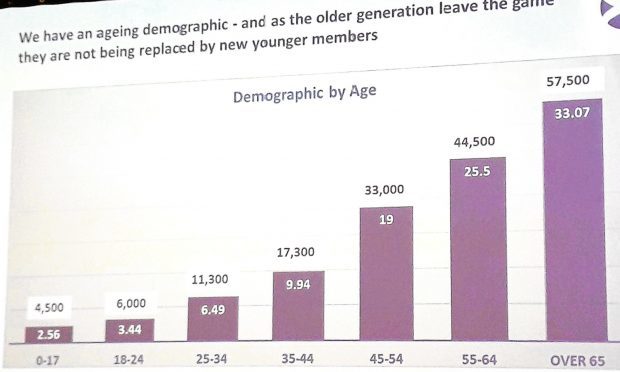Even if you hadn’t been there before, it was quite simple to find your way to the Edinburgh International Conference Centre on Saturday morning.
All you had to do was look for people over 50 carrying folders. It was short odds they weren’t Christmas shopping but headed to Scottish Golf’s Future of Golf Conference.
Once inside the EICC, it took me a while to find a delegate under 30 – Ross Kellett, the Challenge Tour pro, filled the gap, however, and then there was Rachel McQueen, the young pro from Troon. But not many more.
So we even had an illustration of Scottish golf’s frankly insane age demographic before Stewart Darling, the tech-head on the Scottish Golf board, put it on screen in a stark graph for the 500 delegates a couple of hours later. Barely 10,000 golf club members under 25. More than 100,000 over 55.
I’ve made constant – almost weekly – reference to this in T2G for months now, and the equally crazy gender demographic which shows barely over 13 per cent of club members are women.
But given the reaction to Darling’s hour and a half treatise on the calamitous potential of doing nothing, this seemed to be news to a lot of people.
Has the penny dropped at last on this? Surely for the delegates in the EICC it has. Armed with Darling’s figures (if not his convincing eloquence) they’ll take it back to their clubs and associations and hopefully convince a few more.
Because if Scottish Golf is to have a future and at least arrest the alarming slide in club membership and participation, it’s obvious that getting more women, families and younger people involved is the absolute key.
The conference, for the most part, was an attempt by Scottish Golf’s board to explain the rationale behind the ambitious plan they’d tabled two months ago that got such a hostile reception from most of the game’s stakeholders.
While that plan was now “off the table” according to SGL chair Eleanor Cannon, it seemed at times as if they were still agitating for specific elements of it.
And delegates seemed convinced. One of the more eyebrow-raising moments for me was during a Q and A session after finance director Malcolm Kpedekpo’s contribution when a delegate from Fife asked that the proposed rise in the annual affiliation from £11.25 to £24 be taken off the table because, he concluded with a flourish, “enough is enough is ENOUGH”.
But instead of the burst of applause the delegate probably anticipated, there was just a few embarrassed claps. As Darling pointed out later, a £12 rise in the levy will be nothing compared to skyrocketing subs if 5000 club members a year continue to lapse.
Kpedekpo, quite correctly, pointed out that if remedial measures agreed by the SGL boards and approved by the stakeholders required such an increase, it would be wrong not to recommend it.
But of course, the penny needs to drop both ways in this discussion. While everyone needs a clear picture of the realities facing Scottish Golf, the SGL board themselves need to understand what is acceptable to stakeholders and what is not.
There’s been a disconnect between SGL and the membership lasting two decades; really since the collapse of the Scottish National Golf Centre 18 years ago, clubs and associations have pretty much distrusted everything the governing body has done.
That’s a bit like blaming the current government for a mistake by John Major – as Cannon pointed out, SGL in its new, amalgamated form is just two years old. But nonetheless the disconnect and the lack of communication was pretty much standard old SGU style when it came to the restructuring plan two months ago – a few presentations, an SGM and railroad the whole thing through.
Cannon admitted with hindsight, she’d have had a public conference like Saturday’s two years ago. It’s impossible to imagine the old SGU or SLGA holding such a thing or taking views from the floor and then promising to go away and study them in detail.
The proof of the pudding on that is what the SGL board do with the blizzard of ideas that came their way from delegates. It’ll be interesting to see what the new chief executive (when appointed, and I saw more than one candidate in the room) does with it all.
But at least there are clear signs that the new board, in stark contrast to previous regimes, want a consensus view, as much as that is possible for a bunch of golf administrators.
I’m an arch-pessimist – 30 years of covering the Scotland rugby team does that to you – and I left the EICC fairly optimistic that something is going to be done about hauling our game into the 21st century.
One more point: every time there’s a discussion about SGL these days it’s pointed out that the old SGU was run by three people from a cottage at the Royal Burgess “and things were better”.
No, they weren’t. That was in the last century. Golf was hostile to women, children and anyone who wasn’t 50 and over. It still is in some places.
Stop looking back, that’s why we’re in this mess. Time to move forward.
